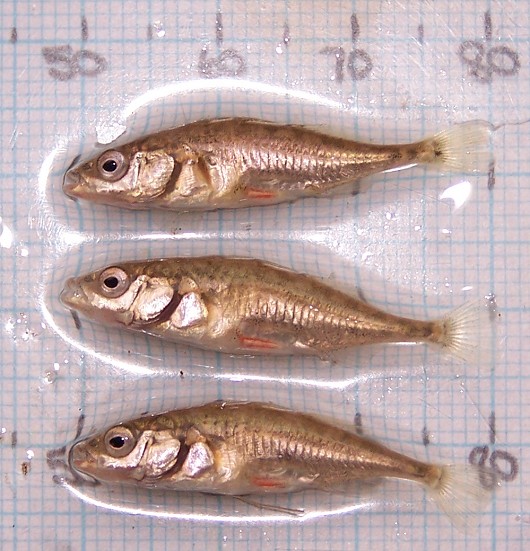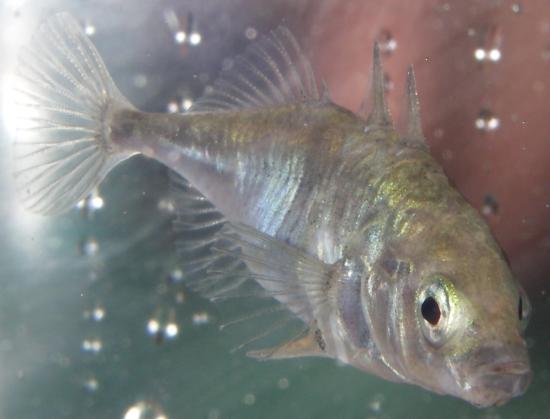
Indostomus paradoxus
FAMILY
Indostomidae
TAXONOMY
Indostomus paradoxus Prashad and Mukerji, 1929, Lake Indawgyi,
Myanmar.
OTHER COMMON NAMES
None known.
PHYSICAL CHARACTERISTICS
Body elongate and slender, with a spatulate snout and terminal
mouth. Eyes large and round. The single dorsal fin contains six
rays, is located at mid-body length, and is preceded by five
short and evenly spaced spines. The anal fin is opposite the
dorsal fin, also with six rays. The caudal fin contains 11 rays
and is rounded posteriorly. Pelvic fins are very small and thoracic,
with only four rays. The precaudal tail region is very
long and slender. Large pectoral fins have 23 rays. Body is covered
by a complex armor composed of numerous plates. Coloration
is a light brown, with numerous small, darker blotches
and irregular stripes. Reaches 1.2 in (3 cm) in length.
DISTRIBUTION
Northern Myanmar, possibly to Cambodia.
HABITAT
Rivers and lakes of northern Myanmar, including the
Ayeyarwaddy River and Lake Indawgyi. Occurs close to the
bottom in canals, swamps, ditches, and stagnant waters.
BEHAVIOR
Mostly unknown. This species apparently is sedentary in river
or lake beds and moves about slowly.
FEEDING ECOLOGY AND DIET
Feeds mostly on worms and other small, slow-moving benthic
invertebrates. Predators are presumably larger fishes.
REPRODUCTIVE BIOLOGY
The reproduction of this species has been observed under captive
conditions. Males defended spawning sites of a few centimeters
inside a tube and had a lighter reddish brown
coloration (instead of the typical darker brown color of nonbreeding
males). There is sexual dimorphism in the pelvic fins:
males have longer and wider pelvics with inward curving rays.
Males displayed by erecting their fins and shaking their tail regions.
Females are lighter brown during spawning, with
bulging abdomens due to the presence of eggs. Females approached
the nesting sites of the male when they were about to
spawn (indicated by their protruding genital papillae) and were
encouraged to enter the tube by the male. The upside-down
female deposited eggs, usually on the roof of the tube; the
male fertilized the eggs while also upside-down. Spawning may
take several hours, and the male guards the nest. From five to
40 elliptical eggs were laid at a time, measuring about 0.08 in
by 0.04 in (2 by 1 mm). Eggs hatched three days after spawning,
and larvae were free-living four days after hatching, at
about 0.14 in (3.5 mm). Larvae have an attachment organ on
the tip of the yolk sac. Larval coloration is unique, composed
of three black vertical bands, and adult coloration is attained
after more than four weeks and at about 0.3 in (8 mm) in
length.
CONSERVATION STATUS
Not listed by the IUCN.
SIGNIFICANCE TO HUMANS
Occasionally imported as an aquarium species.
Photo Gallery of - Armored stickleback





 Animalia Life
Animalia Life